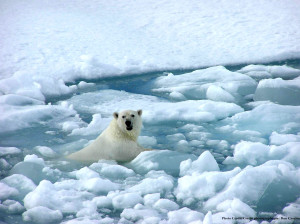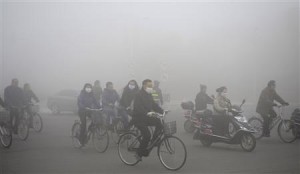By Ruby Setara
What comes to mind when someone mentions global warming? Facebook pictures of skinny polar bears on sheets of broken ice? Local news reports of scientists arguing over whether or not climate change is actually occurring? What about people taking to streets with large signs printed, “THE END IS NEAR?” Maybe nothing at all?
Global warming is an issue that is sometimes disregarded as a “theory,” but the signs of climate change are greatly apparent in many regions of our beloved planet, one popular example being the heavy concentrations of smog in Beijing, China. The thought of planet Earth, once flourishing with life and potential for many great things, as an uninhabitable wasteland is very depressing, but to avoid this, we need to be aware and all play a role. What does this all mean?
What really is global warming, though? And why is it such a big problem?
Global warming is a term used to refer to how the overall temperature of our planet is starting to increase due to greenhouse gases, which are gases that are emitted when humans do things like drive cars or use air conditioners. The use of these things releases and traps heat into the atmosphere, and as the air circulates around the world, the overall temperature of the air increases. Get ac replacement gainesville fl to have an ac that’s better for carbon footprint. According to the EPA (Environmental Protection Agency) website, the gas to consider when it comes to global warming is carbon dioxide. The burning of fossil fuels (for driving vehicles), deforestation, and certain industrial actions releases more carbon dioxide into the atmosphere.
What does trapping the gas in our atmosphere mean for the inhabitants of our planet? According to the EPA, it could mean more severe storms, which can lead to destruction of roads, bridges, homes, and can take lives and displace many people. Changing weather patterns could also mean the destruction of many habitats and ecosystems. Due to the melting of glaciers (caused by a warmer temperature on earth) and expansion of water particles (heat causes water to expand), the sea levels have started to rise, which can mean the oceans can cover land, leaving behind infertile farmland while causing the destruction of homes and ecosystems. All of these examples pose a serious threat to the healthy existence of planet earth.
WHAT ARE THE C.O.P MEETINGS?
There have been climate change meetings called “Conference of Parties” (COP) to discuss and find resolutions to our changing environment. The meetings happen annually. The most recent meeting happened in December 2015, making it the 21st meeting since 1995. At the meetings, world leaders come together and assess the current state of our atmosphere and environment and how to improve the conditions of our planet. Attending the meetings are leaders such as Xi Jinping (President of China), Barack Obama (President of the USA), Francois Hollande (President of France), and Narendra Modi (Prime Minister of India), as well as representatives from over 190 different countries.
WHAT HAS HAPPENED IN PREVIOUS MEETINGS?
COP21 wasn’t the only meeting deemed successful because all countries agreed on a solution. For example, COP11 introduced the Montreal Action Plan, which was a continuation of the Kyoto Protocol, which aimed to reduce the amount of carbon emissions into the atmosphere and to keep them from interfering with the climate system. At COP17, the Green Climate fund was created to support developing countries to help defeat climate change.
However, not all the meetings were considered successful. COP15 in Copenhagen failed to reach an agreement and was labeled an “embarrassment.”
WHAT HAPPENED AT COP21?
A lot has changed since COP20 the previous year; carbon emissions have greatly increased and even though countries made promises (or attempts) to follow the plan, they did not do so well; the smog levels in Beijing were dangerously high near the ending of 2015, making it almost too risky to go outside just wearing a face mask.
At COP21, the world held its breath before the new plan announcement. National Public Radio claims the goal for 2016 is to “set the goal of limiting the world’s rise in average temperature to ‘…well below 2 degrees Celsius above preindustrial levels and pursue efforts to limit the temperature increase to 1.5 degrees Celsius.’” But was the goal approved by other countries? Were other countries willing to sacrifice billions of dollars to save our planet? Yes! A total of 195 countries (including some developing countries) adopted the Paris climate agreement!
WHAT DOES THIS MEAN IF THE GOALS ARE REACHED?
If carbon emissions really do decrease (and it will take a joint effort of all countries adopting the Paris climate agreement), then we will have to cut down on major practices that allow many of our industries to thrive like managing a rubber factory, cutting down trees to make those factories, or even cutting down the amount of vehicles allowed on the road each day.
What would the earth look like without humans disrupting the planet with machines and industries? Altogether, a planet where natural disasters are less frequent and less severe. There will be more space to replant the crops and the air we breathe can be fresher. If action is taken in cities, respiration-related diseases such as asthma, can gradually decrease. There is so much hope for this planet, it only takes our genuine effort to better ourselves and the people around us.

